Book Clubs #1 – Getting Started

I love, love my school library book clubs. So much love. I love having the opportunity to chat with our readers, to compare ideas, argue about what makes a good book, laugh, have fun, celebrate reading and just chill out. When you think about all the extra curricular activities that happen in a school, so many of them are focused around sport, music or art. Reading is so important and yet there are only a few extra-curricular activities that give readers a chance to connect. Reading can also be a very solitary hobby, so it is important to give our young readers a chance to get together in a safe space. Book clubs are the perfect solution.
When I think about what I love most about the school library I work in, my answer is without a doubt the students and especially the members in my book club. I use them as a place to connect with the students, as a chance to bounce ideas off my keen readers, get their insight into new books and the best books in the collection.
So, you want to start a book club. You’re convinced, you think it’s a great idea. But maybe you’ve tried to start a book club before and it didn’t work out. Or maybe you are just not sure where to start. In this 3 part series, I will share all my book clubing experience, the ideas that worked for me, and those that didn’t. I encourage you to give school library book clubs a go (or maybe another try).
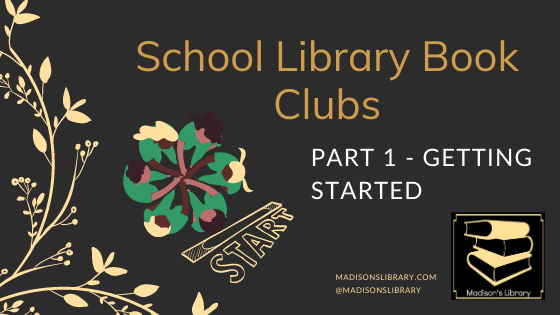
Where to start
Start with the students. You may want to run a book club or a certain type of club, but if you don’t base it around your students and what they want, it will never work.
Talk to your readers. You know your keen readers. They may be the students tucked in the back corner at lunch. Or maybe the ones who pop in to borrow a book almost every day. Ask them if they have ever been in a book club. Ask them if they would be interested in joining a book club. If you are lucky, like I have been in the past, students will come and ask you to create a book club for them. In fact, I routinely have students begging for a book club. Start small. Plan out the ideas you have, your students’ ideas and any feedback you get from them. Once you are sure you have enough interest (and for me, that can start with just a few students), start planning.
Who
It’s not just students that your book club can host. Your school library has access to many different groups of people that may be interested in a book club.
- Students only
- Staff only
- Students and staff
- Students and parents
- Parents only
- Combo themed – mother/daughter, father/daughter, mother/son, father/son. Remember to be inclusive, so it might be daughter and significant male in their life.
- Themed: Writers and readers, Reviewers, Mystery Book Lovers,
- Restricted age groups – Year 1-2, Year 7-12
Again, be guided by what your students/staff/parents are interested in and if you are not sure, just start asking.
I have run:
- Weekly lunchtime Year 1-2, Year 3-4, Year 5-6 and Year 7-12 Book Clubs
- Mother-daughter book club for one year group, twice a term meetings
- Twice a term, Year 7-12 book club, informal at lunchtime
- Online only, reviewers focused book club
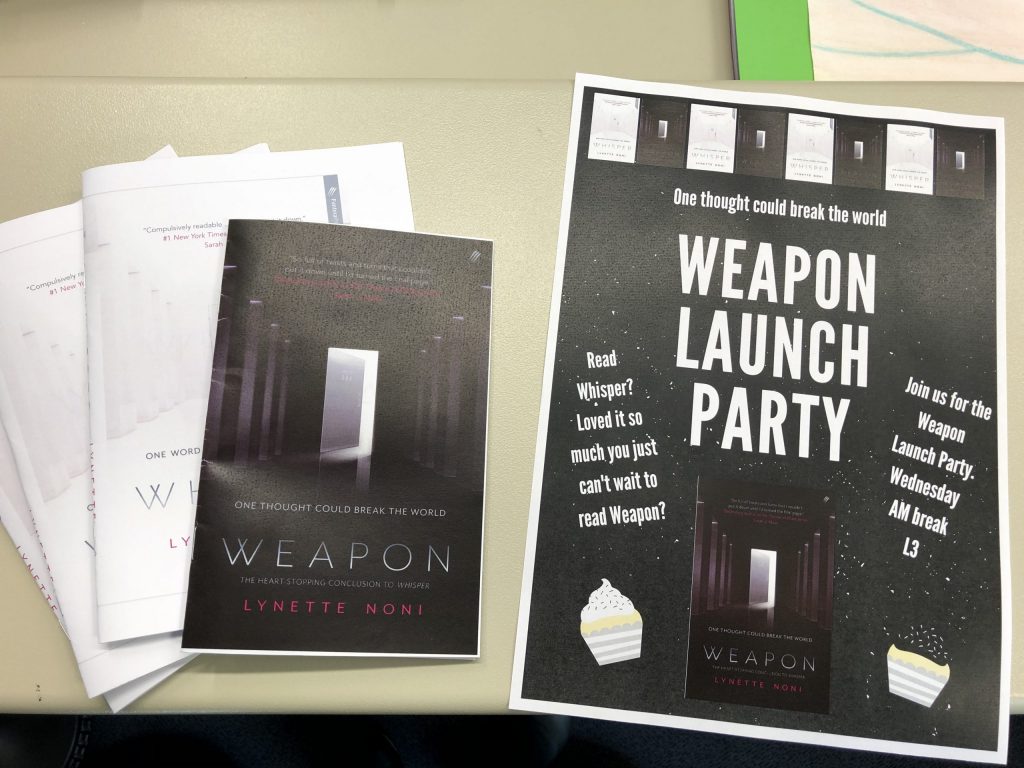
Book Clubs can get involved with book launches – with party food, of course.
What
A book club, right? But there are so many different types of book clubs. Lunchtime, before or after school, themed, weekly, monthly, termly, once or twice a year. Face-to-face, online or a mix of both.
Define your book club
You might also have a particular interest or focus for your book club. This might be defined by the age group involved or it might be due to the theme of the club. Maybe you have a comic and graphic novel themed book club (we’ve done that, but recruited a teacher who loved comics to run this very successful book club), or maybe it is for readers of fantasy. Maybe your book club overlaps with a gardening club, chess group or non-fiction interest group. This might be something you set out at the start or something that evolves over time. Go with student interests and be guided by your members.
My usual book club structure is to divide by year groups and then sometimes by interest. This generally helps to group students by interest. But I also have some book clubs that overlap with age groups and are different in meeting type, their interests and setting.
Here’s an example. Year 7-12 Book Club and Year 10-12 Book Club. They overlap in ages but my Year 10-12 group are much more interested in mystery and realistic fiction than my fantasy and paranormal loving Year 7-12s. My Year 10-12 group only catch up online, via a school platform book club page, where the Year 7-12s meet face to face, as well as having an online platform. The Year 10-12 talks much less frequently than the Year 7-12s, but they have a bigger focus on making recommendations to each other and writing reviews of the books they read.
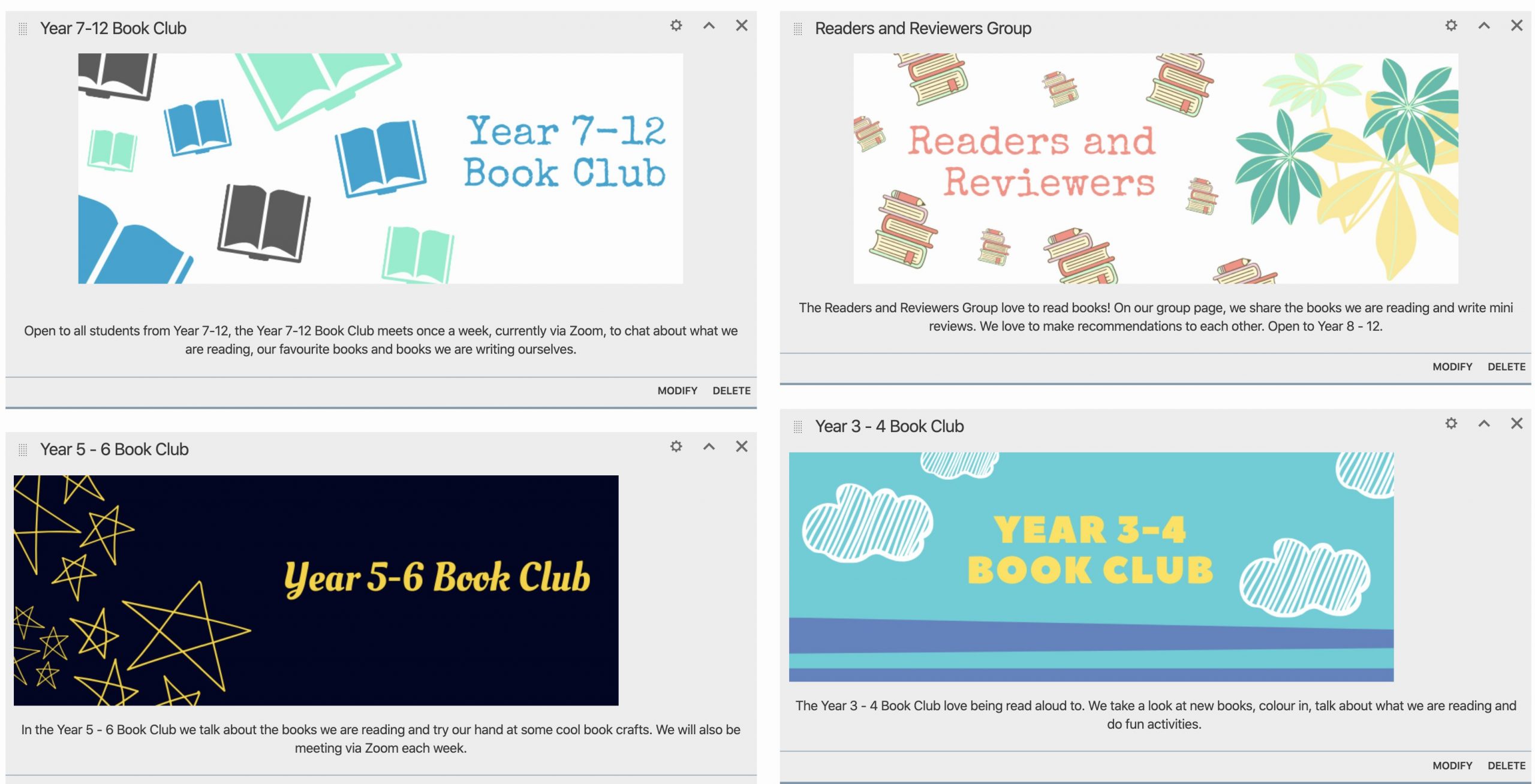
To Eat or Not to Eat?
For me, that is a very silly question. All my book clubs have involved food (even during COVID). Do sport teams get halftime snacks and break-up parties? Do the musical group have celebratory meals? Yes and yes, so why shouldn’t book clubs have snacks involved. They don’t have to be themed (though they can be and that is super cool). For my weekly book clubs, I usually host an end of term party, with just a food items to share. Other book clubs have involved food at each meeting (lollies, chips, savoury snacks), but these are usually the less frequent book clubs. Parent or staff book clubs always have a coffee shop setting or a bring a plate arrangement. And I usually like to include food in other ways – my favourite as lollies for pop-up quizzes and trivia sessions, which the students ADORE. I should note that one of my schools doesn’t support the purchasing of my book club food and so I do that from my own money. It is worth it, but can get expensive, so try and get support from your leadership if possible – use the example of spending of other extra-curricular groups.
What are we going to talk about?
Now you need to decide what your book club is going to do during your meetings. I am going to talk a lot more about this is the third part of the series, but it’s a key defining part of your book club set-up.
Informal
Almost all of my book clubs have been informal places to come and talk about what you are reading or writing. We do fun activities and quizzes, but mainly we just chat. I start by asking the question: what have you been reading? Sometimes the students have lots to talk about, other times they are so weighed down by assignments, they haven’t had time to read (this is especially true for my older students.) Sometimes we just have a chat about what is going on for them in their lives.
Book club members might like to bring in a copy of their book and others grab it once they are done with it. We might give a star rating or a summary of the book. Sometimes, if things get distracted and off topic, I bring them back together and do more of a round circle discussion, with each person getting a chance to talk, other times I just go with it, and we break into smaller groups to just chat. I find that it is the students who really want to stay on topic and get cross with their peers if they are chatting about things other than books. I once created a talking stick (Dumbledore’s Elder wand) to help keep my students respectful of the person talking, but we don’t usually need that anymore. Here are some of things we have done during my informal book club:
- Talking about books we have been reading
- Looking at the new books in the library
- Celebrating a book’s launch (with cupcakes).
- Quizzes (with lollies)
- Colouring in
- Related book activities and craft
- Watching book trailers
- Watching book to movie trailers
- Entering publisher competitions to win books
- Creating book recommendation lists and posters – top ten favourite books
- Talking about our writing and sharing pieces of our writing with the group
- Helping with displays preparation and design
- First choice for book events and excursions
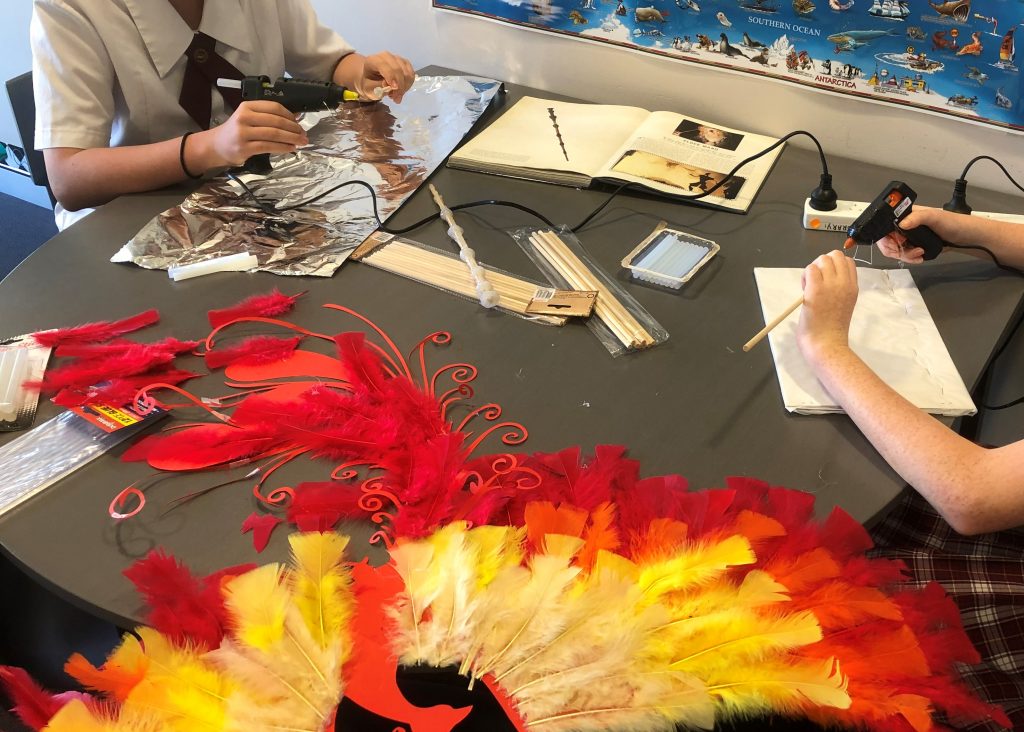
Making Harry Potter wands and helping to make a Book Week display piece.
Formal
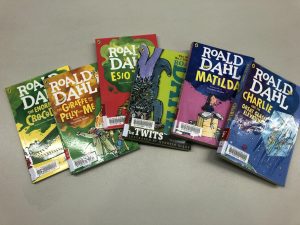
Set a theme from which students choose a book to read.
Other book clubs might have a more structured arrangement. Your group might choose one book all group members read over the term/month. If your own school library doesn’t have enough copies for all your group members, check out what your local public library has, as they often have book club sets you can borrow. I had one middle school book club that started off informally, but we ended up deciding to do a group read. I offered the students a range of choices and they made certain requests – like the book being both a novel and graphic novel (something that is far more common these days, thank goodness). Other book clubs might instead choose a topic or category from which group members select a book to read (shortlist books or particular award winners). Once the book has been read, all group members join up again to discuss the book. Set discussion questions might be shared for members to reflect upon. You might also have a themed activity that ties in with the book.
Other ways you might share a group read, especially with younger students is to read the book aloud during book club. I have done this with Year 2-5 students before. As a group, we selected a book and then read a few chapters each week while doing colouring in and related activities.
Let’s Talk Group Reads. I am not a massive fan of group reads in book clubs. I usually stick with the more informal book clubs, where readers just discuss what they have chosen to read. But group reads can also be really successful. Here are some tips for making it work:
- Have lots of copies. Use both the school library and local public library resources.
- Have different formats. Get the audiobook, ebook, and graphic novel (if there is one) as well as the novel.
- Is there a movie tie-in that readers might like to watch as a group after reading the book?
- No pressure. Make sure you have a very low pressure setting. If they didn’t finish the book, didn’t like the book, or just didn’t have time, make sure there is space for these students to talk about their experiences and maybe something else they read.
When and Where
At the school’s coffee shop, in the library, out in the grounds somewhere. Honestly, the limits are only what you are limited by. COVID has certainly changed some things about book clubs, but many things can remain the same or with added features.
Once you have your who, your what should be easier to narrow down. Parents and staff are likely to enjoy the coffee shop setting and prefer an after or before school time. Less frequently might suit them. Students might be available after school or a lunchtime setting might work best. If you are combining your book club members, try and pick something that works for the majority of attendees. I have sent out polls and asked my members to suggest days and times that work best for them. We try and work with the majority.
Here are some ideas:
- Lunchtimes
- Before school
- Breakfast themed
- After school
- Weekend
- Evening
- Food-based – bring a plate to share
- Online only
- Face-to-face
- Combination of online and face-to-face
How
COVID actually taught me a lot about the different ways we can connect as a book club. My book clubs long had pages on the school learning platform, where we connected via chats, completed polls, took quizzes and I posted updates on our meeting times and bigger events. When COVID hit, we moved to Zoom, still running our usual Book Club meeting but online. When school resumed, we started meeting face-to-face again, but kept the Zoom link in for any students still at home or away sick. It gave us some flexibility.
Face-to-face is the traditional method for book clubs and it is my favourite. But I love having a digital platform where I can connect with my book club members outside of the meeting times.
There is no way I can do it all!!
I know how busy it can be in a school library. You are already running flat out, so there is no way you can fit in a book club (or two or three). I would suggest that a book club needs to come pretty high up on your priority list. I run two weekly book clubs at lunchtime. I am fortunate to have a team who man the library while I run the book club, but if you don’t, set book club up somewhere in the library where you can still supervise the rest of the students (and maybe catch their eye and encourage them to join).
Other options if you are time poor is to build a book club and then demonstrate its success to leadership, asking for extra library staff team members or teachers to be rostered on for lunchtime supervision so you can run book clubs.
A final suggestion is to ask older students to run book clubs for the younger students. As I leave my school this year with my major book clubs, we have asked a Year 10 student to take over running the Year 5-6 book club and some of our Year 6 book club members to run the Year 1-2 book club. Each of these students has been super excited by the possibility. It has worked, as they have already had years of experiencing book club. They know how I run the clubs and they are keen to take over, implement their own ideas and make it their own.
Next time, we will be talking about how to promote your book club and get members to join and stay in your book club.



What an informative read. I’ve been meaning to start a Book Club all year… but it’s been quite a crazy year for everyone! I also have been trying to work out how to go about it so your post has really helped me think and see what would work for this school. I work in a Primary School and I am always looking at ways to encourage the students to read. I look forward to part 2. 🙂
Thank you so much. I absolutely love my Book Clubs and talking about them. They are so much fun and it allows me to really get to know our library readers. I am so pleased this helped. If you are looking for more ideas and a step-by-step guide, check out Megan Daley’s Book Club Course on her website https://childrensbooksdaily.com/build-a-book-club/
I hope you give a book club a try – primary school aged students are usually pretty keen. Good luck and let me know how it goes.